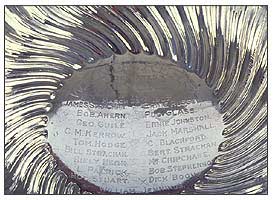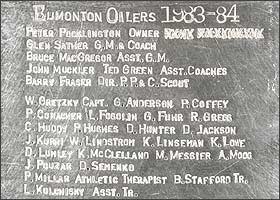(June 30, 2003) -- Before the New Jersey Devils won the Stanley Cup this spring, 2,200 names had been engraved on the Stanley Cup. These men and women, all immortalized by the strike of a punch on the silver veneer of hockey's most revered prize, are almost all hockey-oriented, but not necessarily players.
 |
| The 1906-07 Stanley Cup Champion Montreal Wanderers engraved within the inner bowl. |
Through the Stanley Cup's long history, there have been just four official engravers. In 1948, the National Hockey League, which at the time was based in Montreal, selected Carl Petersen as the official engraver of the Stanley Cup. Petersen, a Danish silversmith, had relocated to Montreal in 1929 and opened a shop called C.P. Petersen and Sons. Carl's son Arno was the second engraver of the trophy. C.P. Petersen and Sons closed their business in 1979, and Boffey Silversmiths was chosen to continue engraving the Stanley Cup. Doug Boffey, the owner, engraved the Cup himself for a number of years, but beginning in 1988, that honour and responsibility have been entrusted to Louise St. Jacques, who has worked for Boffey Silversmiths since 1978.
The first team to have the names of each member of its roster engraved on the Stanley Cup was the 1907 champion Montreal Wanderers, although the tradition didn't become an annual rite until 1924 when the Montreal Canadiens captured the Cup. But there are some true oddities - the first (and only) non-human name engraved on the Stanley Cup is 'Bow Wow,' who may have been the mascot of the Stanley Cup champion Quebec Bulldogs of both 1912 and 1913, or may just have been a tribute to a player's favourite pet. Lily Murphy was the first woman to be honoured. Her connection to hockey is dubious, but her husband Dennis, whose name is also on the Cup, was president of the Bank of Ottawa when the original Ottawa Senators won the Stanley Cup in 1911. Murphy was a colleague of M.J. O'Brien, who donated a trophy for the champion of the National Hockey Association until that league's demise in 1917. O'Brien's son Ambrose had founded the NHA, a forerunner of the NHL. After Lily Murphy, the next woman to have her name engraved on the precious trophy was Detroit Red Wings' president Marguerite Norris in 1955.
 |
| The misspelled 1980-81 New York Islanders engraving |
To earn the status of getting your name engraved on the Stanley Cup, players must play at least 40 games through the regular season or one in the Cup final. Although not an official ruling, this standard helps dictate those who are considered part of the championship team. This ruling has allowed players like Aut Erickson and Milan Marcetta to get their names on the Stanley Cup. Neither played a single regular season game for the Toronto Maple Leafs in 1967, but both played in the Cup final and as a result, earned the honour. Teams can get dispensation to include players it deems worthy to add. In 1970, the Boston Bruins included Ted Green on their list of engraved names. Green was injured in a violent pre-season game that season and missed the entire campaign, but was an integral part of the Bruins' franchise nevertheless. Although it is certain he would have been included by the Devils' anyway, goaltender Corey Schwab played just eleven games behind Martin Brodeur during the regular season, but ensured his name would be on the Cup with an appearance in the final against the Mighty Ducks.
If a fine leather can be evaluated by its individual flaws, then so too can the Stanley Cup. Each team name, each individual, is carefully measured and, taking hammer to punch, individually tapped into the Stanley Cup. But adding to the allure and curiosity of the Cup are the errors that have been made through the years. The 1962 Cup-winning team is represented as the Toronto Maple LEAES. In 1972, the Boston Bruins were misspelled as coming from BQSTQN. The New York Islanders became the ILANDERS in 1981. Individual names have been incorrectly engraved through the decades too. Pete Palangio of the 1938 Chicago Black Hawks is engraved twice; once correctly and once as PALAGIO. Turk Broda also had his name engraved twice in 1942; once as WALTER Broda (his given name) and once as TURK Broda, his nickname. In 1947, Maple Leaf Gaye Stewart was spelled GAVE, while Ted Kennedy became KENNEDYY in 1951. In 1952, when the Detroit Red Wings won the Stanley Cup, Coach Tomy Ivan was shocked to see his name spelled NIVAN, while Alex Delvecchio was engraved as BELVECCHIO. During the Montreal Canadiens' dynasty of five consecutive Cup wins between 1956 and 1960, poor Jacques Plante had his name spelled five different ways. Bob Gainey of Montreal was Bob GAINY in 1975. In 1984, Edmonton Oilers' owner Peter Pocklington included his father's name on the list for the engraver. But Basil Pocklington had no affiliation with the team, so the NHL insisted on the name's removal. Sixteen 'Xs' now cover the name of Pocklington's Dad.
 |
| The 1983-84 Edmonton Oilers engraving with the X'd out Bazil Pocklington. |
Once the Stanley Cup has concluded its tour of duty with each of the New Jersey Devils' warriors, it will return to the office studio of Louise St. Jacques in September. There, using a small hammer and stamp for each of the individual names and numbers that will be added to the bottom ring of the Stanley Cup, the 2002-2003 champions will have their names engraved to be honoured in perpetuity. Each name takes approximately thirty minutes to inscribe. After a good polish, the Stanley Cup will be ready to return to New Jersey for the start of the 2003-2004 hockey season.
On Monday, June 30, the Stanley Cup will be guest of honour at the launch party for the New Jersey Devils' '2002-2003, Stanley Cup Champions' video, and you'll have a front row seat no matter where you live with Wednesday's STANLEY CUP JOURNAL.
Kevin Shea is a hockey journalist and historian based in Toronto.
|